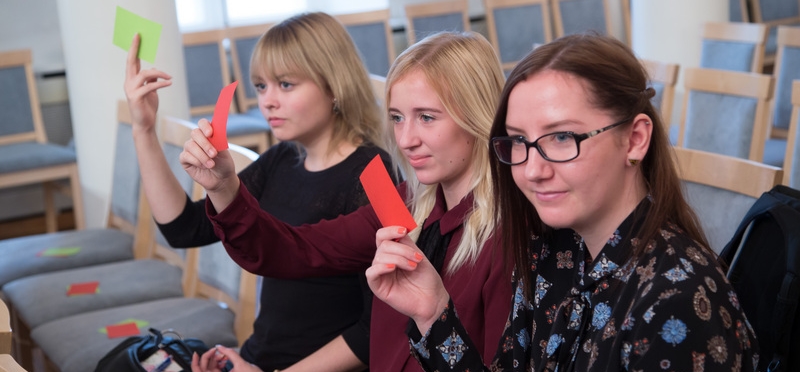- Home
- Study book
- Week 1: Introduction to multilingualism and plurilingualism
- Week 2: Understanding bilingualism
- Week 3: Multilingualism in state and society, and the role of communities
- Week 4: Early Childhood Multilingualism
- Week 5: Multilingual school
- Week 6: Multilingual higher education
- Week 7: Interculturalism and intercultural communication
- Course team

MOOC: Multilingual Education
Week 7 Pool of ideas for seminars
The readings, videos and activities below are designed to provide opportunities for deepening your knowledge about the topics covered in Week 7 of the MOOC (e-Course) “Interculturalism and intercultural communication”. It is aimed to be used in academic seminars, providing extra materials, some suggestions for activities, etc.
In order to become familiar with the basics of the topic, it is recommended that you go through the self-study e-Course as follows:
- To get generally acquainted with the topic and terms of .., study the MOOC materials of Week 7 part 1 here: https://sisu.ut.ee/multilingual/7-1-intercultural-communication
- … Week 7 part 2 here: https://sisu.ut.ee/multilingual/7-2-critical-incidents-cross-cultural
- … Week 7 part 3 here: https://sisu.ut.ee/multilingual/7-3-developing-intercultural-communication
- Complete the Week 7 quiz here: https://sisu.ut.ee/multilingual/multilingual-quiz-7
Extra materials for academic seminars or individual learners for learning more profoundly about the topic of interculturalism and intercultural communication:
Module 7.1
Apedaile, S. Schill, L. (2008): Critical Incidents for Intercultural Communication.
https://www.norquest.ca/norquestcollege/media/pdf/centres/intercultural/criticalincidentsbooklet.pdf
In the first part, the authors describe critical incidents, their significance for language learning and state objectives for intercultural learning. In the second part, they focus on different models of culture and define and relate prejudice, stereotype and discrimination. In the third and last part, there are critical incidents cards which cover stories or activities to work and reflect on.
Module 7.2
Thomas, D. (1994): Understanding cross-cultural Communication:
https://www.researchgate.net/publication/257880583_understanding_cross-cultural_communication
In this paper, examples of cultural differences in communication in Australia and New Zealand are presented. Two approaches to the training of cross-cultural communication skills are described: the cultural assimilator developed by Brislin, and McCaffery’s “learning how to learn” orientation.
Module 7.3
European centre for modern languages (2007): developing and assessing intercultural communicative competence.
http://archive.ecml.at/mtp2/publications/b1_iccinte_e_internet.pdf
The authors argue that the focus of foreign language teaching is still primarily on language learning and lacks focus on intercultural communicative competence. With their guide they describe and explain terminology, followed by guidelines for intercultural communication workshops and material to support the development of intercultural competence. In a second part, they give recommendations for assessing intercultural competence and discuss different dimensions of ICC.
Intercultural encounters – from culture and multicultural societies to pluriculturality and plurilingualism
Byram, Michael et al. 2009. Autobiography of Intercultural Encounters. Strasbourg: Council of Europe Publishing. https://rm.coe.int/context-concepts-and-theories-autobiography-of-intercultural-encounter/168089eb76
The Autobiography of Intercultural Encounters is a concrete response to the recommendations of the Council of Europe’s White Paper on Intercultural Dialogue “Living together as equals in dignity” (http://www.coe.int/dialogue), Section 5.3 “Learning and teaching intercultural competences”, paragraph 152:
“Complementary tools should be developed to encourage students to exercise independent critical faculties including to reflect critically on their own responses and attitudes to experiences of other cultures.”
The authors are intending to contribute to the development of intercultural competence and will facilitate the emergence of intercultural citizenship amongst those who use it.
It is suggested to read pages 6 – 18.
Discussion and reflection questions for the seminar:
- The understanding of culture and its elements: What where the elements you already knew and what elements were surprising to you? Why so?
- Does the situation in your country/area/community seem to be multicultural? Explain, how did you come to that conclusion.
- Do you consider yourself a pluricultural person? Explain, how did you come to that conclusion.
- In what way your country/area/community supports tolerance and respect towards plurality? What could be improved?
Intercultural education
Culturally relevant pedagogy (AKA ‘culturally responsive’ pedagogy) https://www.youtube.com/watch?v=nGTVjJuRaZ8 (for teacher training)
Multiculturalism in children’s literature/Večkulturna mladinska književnost
The article below presents an analysis of children’s literature in Slovene from the point of view of multicultural and thematic elements, an analysis of the syllabus and an analysis of children’s literature in accordance with European concepts of equality as well as cultural, religious and linguistic diversity. Read the article and discuss the following:
What is a multicultural children’s book?
How can multicultural literature help children look critically at the world?
How can reading multicultural literature develop children’s empathy?
Reading: article by M. M. Blažič: Večkulturna mladinska književnost: http://pefprints.pef.uni-lj.si/5576/1/Blazic_M._M._Veckulturna_mladinska_knjizevnost_2005.pdf
Historical and ideological features of legal language
The legal language with its register reflects historical developments, but also moral and ethical values of a community at a particular point of time in a very distinctive way. When studying it, interesting historical and ideological features can be discovered.
Reading: extract from the paper Behind the Scenes of Legal Discourse by A. Kocbek available at https://e-knjige.ff.uni-lj.si/znanstvena-zalozba/catalog/view/160/256/4125-1
I. Circle the right answer
1. Which language has had the greatest impact on Legal Slovene?
- Italian
- English
- French
- German
2. Words such as pravo (law) and sodba (judgement) have their origin in
- Latin
- Old Slavonic
- German
3.The terms pravni posel, izjava volje, predpis
- existed in the everyday language before they became legal terms
- were created through translation from German
- are loanwords from English.
4. In the period from 1918 to 1991, as Slovenia was part of Yugoslavia, some legal terms such as “zaključek” and “tajnost” entered the Slovene legal vocabulary. Which language(s) were they derived from
- Albanian
- Serbian/Croatian
- Macedonian
5. English as the modern legal lingua franca, has also absorbed a number of words from different languages. Which are these languages?
- Greek
- Latin
- French
- German


